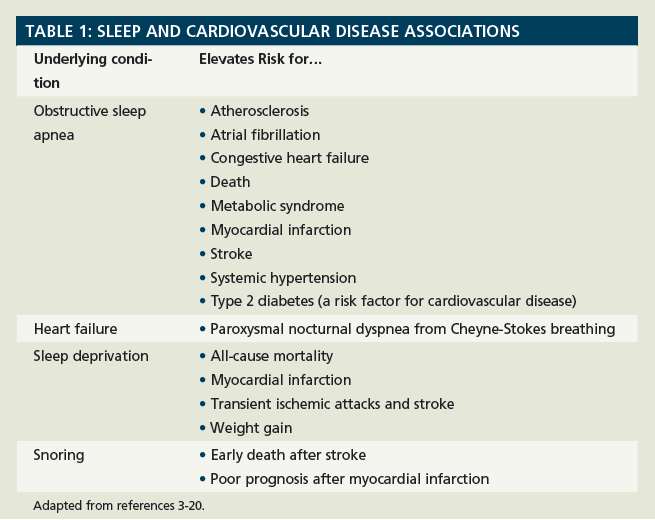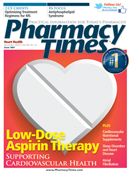Publication
Article
Pharmacy Times
Sleep Disorders and Heart Disease: A Reciprocal Relationship
Author(s):
Poor sleep quality and cardiovascular disease often go hand in hand.
Poor sleep quality and cardiovascular disease often go hand in hand.
The Centers for Disease Control and Prevention calls Americans’ propensity to skimp on sleep “a national epidemic.” The agency reports that up to 70 million American adults have a sleep disorder.1 Cardiovascular disease—another epidemic—kills 1 in 4 Americans.2 Disturbed sleep and cardiovascular disease (CVD) have a reciprocal relationship: poor sleep quality may cause or contribute to CVD, and CVD may perturb sleep (Table 13-20). This hand-in-hand relationship should encourage health care providers to ask about and monitor both issues when patients present with either. This article examines the sleep-CVD relationship and potential interventions to create a health care win-win.

Sleep-Disordered Breathing and Cardiovascular Disease
Sleep-disordered breathing (SDB) is a spectrum of conditions that can alter sleep. Most SDB leads to sleep deprivation. Results of physiologic studies demonstrate that sleep deprivation can impair insulin sensitivity and create hormonal changes that increase hunger and appetite. 20,21 As a manifestation of this change, individuals who sleep fewer than 7 hours a night are more likely to carry excess weight—a CVD risk factor—than those who sleep more than 7 hours.22
Specific sleep disturbances seem to have unique effects on CVD. For example, 1 in 15 Americans, or roughly 7% of the population, has obstructive sleep apnea, the most common form of SDB.23 This condition is clearly associated with CVD, and results of well-controlled studies show that patients’ blood pressure improves when their sleep apnea is treated adequately.24 Researchers believe that sleep apnea creates nocturnal blood pressure surges that contribute to plaque rupture.25 They also suspect that autonomic factors—inflammation mediators, oxidative stress, negative intrathoracic pressure, hypoxemia, arousal from sleep—and metabolic factors conspire to cause acute hemodynamic alterations.26,27 Hypoxemia in particular boosts venous return and increases pulmonary arterial pressure, which elevates right ventricular pressure, blood pressure, and heart rate.28 Nitric oxide is critical in cardiovascular pathways, and reactive oxygen species decrease nitric oxide production and may inactivate bioavailable nitric oxide.29

More than half of patients with heart failure have sleep abnormalities, which generally fall into 2 categories.30,31 About one-third of heart failure patients with left ventricular dysfunction have obstructive sleep apnea, and one-third experience Cheyne-Stokes respirations, a form of central apnea characterized by deeper, faster breathing. The remaining third have miscellaneous CVD conditions that disturb sleep.30
On the other hand, SDB is a risk factor for recurrence and mortality following stroke or transient ischemic attack. Evidence suggests a dose-response relationship between the severity of a patient’s SDB and his or her risk for serious adverse outcomes after stroke and transient ischemic attack.32 Within the first 48 hours after a stroke, most patients experience nocturnal deterioration. Researchers think that dysregulated autonomic function exaggerates hemodynamic changes during sleep, causing arrhythmia and blood pressure fluctuations in stroke patients.33
Managing the Sleep—Cardiovascular Disease Combination
Clinicians need to screen for comorbid SDB and CVD and establish accurate diagnoses. A full diagnostic workup includes a medical history and physical examination. If obstructive sleep apnea cannot be ruled out, a sleep study (polysomnography in a sleep laboratory or a home sleep test) should be conducted.34
The clinician’s first step in treating patients with heart failure is to optimize medical therapy because adequate dosing of cardiac medications resolves Cheyne- Stokes respirations.35
General steps to improve sleep are listed in Table 2.34 In addition, clinicians should consider prescribing sedatives/ hypnotics if the patient’s comorbidities and demographic factors are not contraindications. Cautious use is advised due the possibility of addiction to some drugs as well as the propensity to cause daytime drowsiness or falls.
Patients who have sleep apnea should be considered for continuous positive airway pressure (CPAP) because it positively influences hemodynamics (Table 336,37). It is critical to remember that the effects of CPAP on hypertension are generally modest, and patients will still require concomitant antihypertensive therapy.35 In addition, many patients have difficulty adhering to CPAP, with total adherence defined as using the CPAP machine every night throughout the entire night. Failure to use CPAP, even for 1 night, allows the symptoms of SDB—daytime sleepiness, neurobehavioral decline, increased sympathetic activity, and significant driving impairment—to return.37,38
Conclusion
The association between sleep and CVD and metabolic health is receiving more attention in the medical literature. Pharmacists can help patients and other members of the health care team appreciate the importance of these conditions. Pharmacists can also suggest appropriate interventions. As our understanding of the mechanisms underlying both becomes clearer, we will have more opportunities to tailor care to specific targets. Until then, we need to help patients sleep as soundly as possible and address CVD conditions as well.
Ms. Wick is a Visiting Professor at the University of Connecticut School of Pharmacy and a former National Cancer Institute employee.
References
1. Insufficient sleep is a public health epidemic. Centers for Disease Control and Prevention website. www.cdc.gov/Features/dsSleep/. Accessed November 13, 2014.
2. Heart disease facts. Centers for Disease Control and Prevention website. www.cdc.gov/HeartDisease/facts.htm. Accessed November 13, 2014.
3. Lavie P, Here P, Hoffstein V. Obstructive sleep apnea syndrome as a risk factor for hypertension. Br Med J. 2000;320:479-482.
4. Lavie P, Silverberg D, Oksenberg A, Hoffstein V. Obstructive sleep apnea and hypertension: from correlative to causative relationship. J Clin Hypertens (Greenwich). 2001;3:296-301.
5. Peppard P, Young T, Palta M, Skatrud J. Prospective study of the association between sleep disordered breathing and hypertension. N Engl J Med. 2000;342:1378-1384.
6. Pepperell JC, Ramdassingh-Dow S, Crosthwaite N, et al. Ambulatory blood pressure after therapeutic and subtherapeutic nasal continuous positive airway pressure for obstructive sleep apnoea: a randomised parallel trial. Lancet. 2002;359:204-210.
7. Nieto F, Young TB, Lind BK, et al. Association of sleep-disordered breathing, sleep apnea, and hypertension in a large community-based study. Sleep Heart Health Study. JAMA. 2000;283:1829-1836.
8. Brooks D, Horner RL, Kozar LF, Render-Teixeira CL, Phillipson EA. Obstructive sleep apnea as a cause of systemic hypertension. Evidence from a canine model. J Clin Invest. 1997;99:106-109.
9. Hung J, Whitford EG, Parsons RW, Hillman DR. Association of sleep apnoea with myocardial infarction in men. Lancet. 1990;336:261-264.
10. Shahar E, Whitney CW, Redline S, et al. Sleep-disordered breathing and cardiovascular disease. Cross-sectional results of the Sleep Heart Health Study. Am J Respir Crit Care Med. 2001;163:19-25.
11. Yaggi HK, Concato J, Kernan WN, Lichtman JH, Brass LM, Mohsenin V. Obstructive sleep apnea as a risk factor for stroke and death. N Engl J Med. 2005;353:2034-2041.
12. Arzt M, Young T, Finn L, Skatrud JB, Bradley TD. Association of sleep-disordered breathing and the occurrence of stroke. Am J Respir Crit Care Med. 2005;172:1447-1451.
13. Janszky I, Ljung R, Rohani M, Hallqvist J. Heavy snoring is a risk factor for case fatality and poor short-term prognosis after a first acute myocardial infarction. Sleep. 2008;31:801-807.
14. Marshall NS, Wong KK, Liu PY, Cullen SR, Knuiman MW, Grunstein RR. Sleep apnea as an independent risk factor for all-cause mortality: the Busselton Health Study. Sleep. 2008;31:1079-1085.
15. Young T, Finn L, Peppard PE, et al. Sleep disordered breathing and mortality: eighteen-year follow-up of the Wisconsin sleep cohort. Sleep. 2008;31:1071-1078.
16. Sahlin C, Sandberg O, Gustafson Y, et al. Obstructive sleep apnea is a risk factor for death in patients with stroke: a 10-year follow-up. Arch Intern Med. 2008;168:297-301.
17. Eckert DJ, Jordan AS, Merchia P, Malhotra A. Central sleep apnea: Pathophysiology and treatment. Chest. 2007;131:595-607.
18. Ayas NT, White DP, Manson JE, et al. A prospective study of sleep duration and coronary heart disease in women. Arch Intern Med. 2003;163:205-209.
19. Kripke DF, Garfinkel L, Wingard DL, Klauber MR, Marler MR. Mortality associated with sleep duration and insomnia. Arch Gen Psychiatry. 2002;59:131-136.
20. Seetho IW, Wilding JP. Sleep-disordered breathing, type 2 diabetes and the metabolic syndrome. Chron Respir Dis. 2014;11:257-275.
21. Flier JS, Elmquist JK. A good night's sleep: future antidote to the obesity epidemic? Ann Intern Med. 2004;141:885-886.
22. Patel SR, Malhotra A, White DP, Gottlieb DJ, Hu FB. Association between reduced sleep and weight gain in women. Am J Epidemiol. 2006;164:947-954.
23. Sleep apnea statistics. Sleep Disorders Guide website. http://sleepdisordersguide.com/sleepapnea/sleep-apnea-statistics.html. Accessed November 13, 2014.
24. Bazzano LA, Khan Z, Reynolds K, He J. Effect of nocturnal nasal continuous positive airway pressure on blood pressure in obstructive sleep apnea. Hypertension. 2007;50:417-423.
25. Chuang LP, Chen NH, Lin SW, Chang YL, Chao IJ, Pang JH. Increased matrix metalloproteinases-9 after sleep in plasma and in monocytes of obstructive sleep apnea patients. Life Sci. 2013;93:220-225.
26. Hilton MF, Chappell MJ, Bartlett WA, Malhotra A, Beattie JM, Cayton RM. The sleep apnoea/hypopnoea syndrome depresses waking vagal tone independent of sympathetic activation. Eur Respir J. 2001;17:1258-1266.
27. Caples SM, Garcia-Touchard A, Somers VK. Sleep-disordered breathing and cardiovascular risk. Sleep. 2007;30:291-303.
28. Jellinek H, Krenn H, Oczenski W, Veit F, Schwarz S, Fitzgerald R. Influence of positive airway pressure on the pressure gradient for venous return in humans. J Appl Physiol. 2000;88:926-932.
29. Walford GA, Moussignac RL, Scribner AW, Loscalzo J, Leopold JA. Hypoxia potentiates nitric oxide-mediated apoptosis in endothelial cells via peroxynitrite-induced activation of mitochondria-dependent and -independent pathways. J Biol Chem. 2004;279:4425-4432.
30. Oldenburg O, Spießhöfer J, Fox H, Bitter T, Horstkotte D. Cheyne-Stokes respiration in heart failure: friend or foe? Hemodynamic effects of hyperventilation in heart failure patients and healthy volunteers. Clin Res Cardiol. Published online November 6, 2014.
31. Javaheri S, Parker TJ, Wexler L, et al. Occult sleep-disordered breathing in stable congestive heart failure. Ann Intern Med. 1995;123:77.
32. Birkbak J, Clark AJ, Rod NH. The effect of sleep disordered breathing on the outcome of stroke and transient ischemic attack: a systematic review. J Clin Sleep Med. 2014;10:103-108.
33. Palamarchuk I, Kimpinski K, Lippert C, Hachinski V. Nocturnal deterioration after ischemic stroke and autonomic dysfunction: hypothesis and implications. Cerebrovasc Dis. 2013;36:454-461.
34. Tien DA, Kominsky A. Managing snoring: When to consider surgery. Cleve Clin J Med. 2014;81:613-619.
35. Diogo LN, Monteiro EC. The efficacy of antihypertensive drugs in chronic intermittent hypoxia conditions. Front Physiol. 2014;5:361.
36. Fessler HE. Heart-lung interactions: applications in the critically ill. Eur Respir J. 1997;10:226-237.
37. Naughton MT, Rahman MA, Hara K, Floras JS, Bradley TD. Effect of continuous positive airway pressure on intrathoracic and left ventricular transmural pressures in patients with congestive heart failure. Circulation. 1995;91:1725-1731.
38. Ye L, Malhotra A, Kayser K, et al. Spousal involvement and CPAP adherence: A dyadic perspective. Sleep Med Rev. Published online May 9, 2014.







